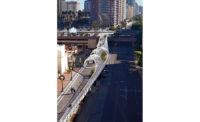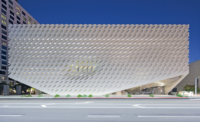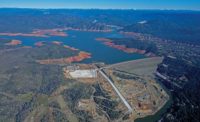Seaworld’s Electric Eel
San Diego
Best Project, Sports/Entertainment
Owner: SeaWorld San Diego
Lead Design Firm: PGAV Destinations
General Contractor: Rudolph and Sletten Inc.
Structural Engineer: EDM Inc.
MEP Engineer: EXP Inc.
Architect: PGAV Destinations
Subcontractor: Cemrock Landscapes Inc.
The Electric Eel is not just another thrilling roller coaster. After a series of loops and twists, the SeaWorld attraction pulls riders up an 150-ft-high ascent where they have an upside-down view of picturesque Mission Bay, then rocks them forward and backward as they speed through the coaster’s station house. The thrills increase as the ride reaches a top speed of 62 mph and becomes the fastest, as well as the tallest, roller coaster in San Diego.
But what makes the Electric Eel really unique is a 450-sq-ft educational exhibit located at its base that contains a live eel habitat and a collection of moray eels.
The project, which was designed by PGAV Destinations and built by Rudolph and Sletten, with EDM Inc. serving as structural engineer, also created a 1,130-sq-ft ride station, an 830-sq-ft maintenance area and 100 sq ft of locker space.
The project team, charged with building the coaster in the middle of a busy theme park, worked on a fast-track schedule. Locating existing utilities such as gas, 12-kv power, sewer, storm drains and fiber optics required extensive exploratory work. Because SeaWorld itself was built in the mid-1960s, the maps of utilities and the park’s as-built documents were not up to date or accurate.
To locate and protect existing underground utilities, crews used vacuum trucks to suck up top soil as a way to avoid potential damage from shovels and heavy equipment.
“Vacuum removal of top soil ensured we had zero utility strikes or interruptions and enabled us to laser-scan and create a 3D model of all existing utilities,” says Nestor Comandante, Rudolph and Sletten project executive. “We used the model to avoid conflicts and determine sequence of installation within the existing utilities.”
SeaWorld’s proximity to the ocean meant that subsurface soil liquefaction was another issue that required attention. To meet strict seismic and static settlement criteria, the engineers designed a ground-improvement solution that utilized cement deep-soil mixing (CDSM). Crews installed more than 200 6-ft-dia columns down to 40 ft depths. The interlocking cement columns formed a barrier around the foundation’s perimeter to support the 11,000-sq-ft mat foundation slab.
While working around the noise and confusion of a busy theme park, the project team maintained an impeccable safety record. Rudolph and Sletten used its experience with other SeaWorld projects to develop a comprehensive jobsite safety plan that resulted in a perfect safety record—zero accidents from the project’s groundbreaking in Sept. 2017 to its early completion in May 2018.
Safety was particularly important when it came to erecting scaffolding and designing a way to protect park visitors from objects that might fall from riders on the Electric Eel after it opened.
Typically, scaffolding systems are attached to the structure under construction. But in the case of the 150-ft-tall Electric Eel tower, no structure existed to secure scaffolding, so the team used OSHA-approved cranes to carry workers in basket cages to reach the tower. There they installed, inspected and tested bolts, connections and other structural features. Next, specialty ironworkers scaled the roller coaster like rock climbers to tighten and paint every bolt at every connection.
To protect park-goers beneath the ride, Rudolph and Sletten built structures to catch falling objects such as cellphones and water bottles.
“Working with the architect, trajectory models were created, and accurate as-built drawings were used to develop a plan to protect the pedestrians near the ride,” says Comandante.
He says the team also performed live tests to see where items would land if dropped from the ride accidently. Based on those tests, the contractor developed a plan using the geometry of the roller coaster, the location of surrounding facilities and the expected path the public would travel around and under the ride.
The solution to the problem was installation of “loose-article netting,” which was fastened to the support structures. “A specialty manufacturer was sourced for protective netting fabrication to meet the tensile strength, strand opening and weather-resistant requirements,” says Comandante.
Rudolph and Sletten used a software program to provide detailed plans for each net, saving time by eliminating the need to verify dimensions in the field. And because some of the netting structures were outside the project boundaries, that portion of the work was performed before and after regular park hours.
Back to "ENR California's Best Projects 2019: Diverse Mix of Public, Private Work Garners Award"








Post a comment to this article
Report Abusive Comment